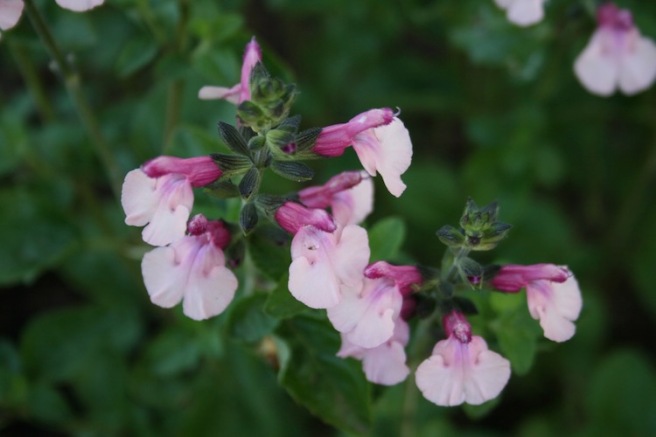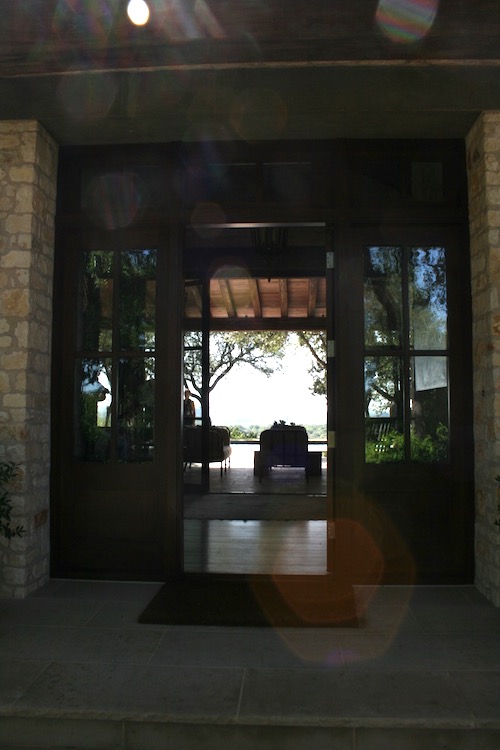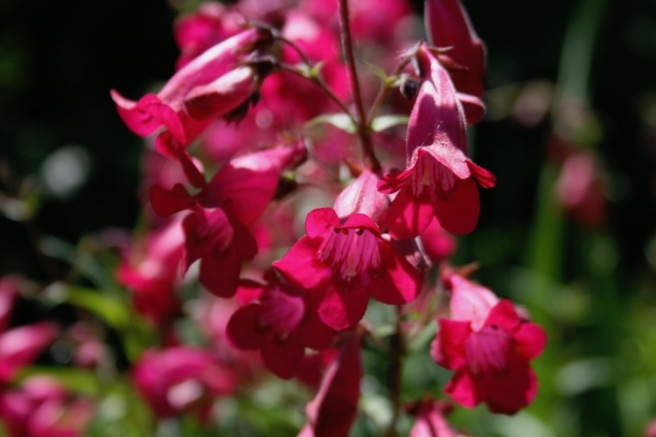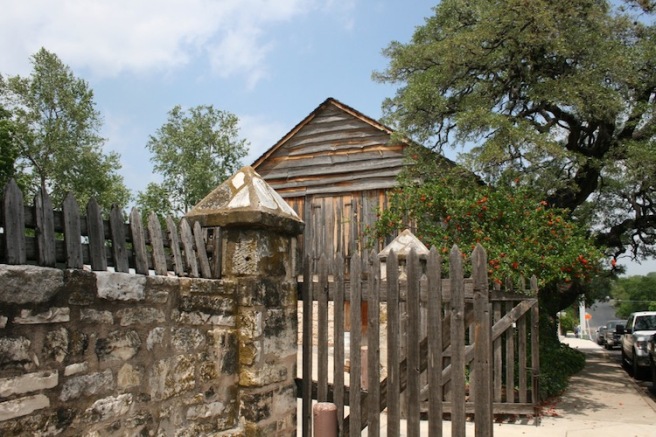In addition to her award winning blog Digging, Pam Penick’s garden creds include founding the Garden Bloggers Fling in 2008, an eight year run as a garden designer and freelance writing credits in well known garden magazines such as Garden Design, Country Gardens and Wildflower. In her spare time (?) she has authored two books, Lawn Gone! and The Water Saving Garden, and organizes an annual series of Garden Spark Talks in her home featuring local designers and garden experts.

My Central California summer shares the heat and drought challenges Pam faces. She calls Austin’s scorching summer sun the Death Star and confides that she does the majority of her gardening in the spring and fall, as I do, and tries to relax in her pool, as I do, through the dog days. Having seen many of Pam’s garden elements from reading her blog over the last few years, I wasn’t sure I would see anything new but I hoped to expand my knowledge of the proverbial ‘spiky things’ that thrive in her landscape. An additional garden challenge for her is what Texas gardeners coyly refer to as ‘deer pressure’. When I lived in Georgia we called ’em like we saw ’em–those #$%&@#ing deer! Periodic torrential rains necessitate well thought out systems of dry stream beds and terracing to direct water away from home foundations and slow runoff down to mitigate erosion, hoping that your plan allows some of that water to percolate down into the landscape. Pam has approached her garden’s challenges with apparent good humor and the willingness to keep trying until she focuses in on the right solution.

Pam describes her home as a “nondescript 70’s ranch”–the fact is that most of us live in nondescript ranches or bungalows or colonials of some vintage. Not to imply that all gardeners regard their homes as brick and mortar backdrops for their effort but for me it’s the garden that makes the home, not the other way around. Pam has added an edgy vibe through her use of contemporary materials and architectural plantings plus a pop of color with her aqua front door.

To the left of her front door this trio of rusty metal planters hold heat lovers not favored by her antlered friends and their families. On the bus Pam shared with us the story of being given the tall metal pipe (which is also sunk into the ground several feet) and the ensuing harrowing effort it took to get the large toothless sotol (Dasylirion longissimum) into its new airy perch. The squaty one is a whale’s tongue agave (Agave ovatifolia).

To the right Pam has planted a variety of leafy green and gray plants tucked up to the foundation, bordered by a gravel path to the back garden. Spring comes very early to Pam’s garden and thus many of her spring bloomers are well past their time.

The rusted metal spiky ‘plant’ was added to the tall container to give it a little more vertical interest.
Pam’s front garden is mostly shaded by mature trees. A hill-like planting area provides a place to add a variety of shrubs, succulents and a few perennials which soften the circle driveway.



Across the driveway a stepping stone path winds toward the back garden. The area features a semi-circle ‘lawn’ of ‘Scott’s Turf’ sedge (top photo, far left) and a shade illuminating patch of flax lily (Dianella). Recently Pam posted photos on her blog of a newborn fawn resting in this shady patch, apparently waiting for mom to return from shopping or lunch!
There is a party going on in Pam’s back garden! She has created a strolling garden of exploration, with lots of places to sit, relax and enjoy the many views.

In a relatively compact space Pam has created multiple garden rooms and seating areas, layering in potted cacti and succulents which do not require her daily attention through the hottest parts of the Austin summer.

The very private and shady back garden is lit up in its center by a curvy, cool aqua pool.

Ok–so where can I get one of these that says FRESNO? The rustic sapling (Juniper?) fencing seems to disappear into the shade.

One of two elevated comfy seating and eating areas. The lot slopes down from the house to the fence and these raised areas offer great garden and pool views. Pam has used lots of interesting containers to add green at many elevations, softening the brick facade and prominent use of stone to make the downhill slope transitions.

The extension of her home into the back yard in a sort of upside down T shape makes this first raised area totally private from the deck just a few feet away.


The deck offers a perfect dining spot with a view of the pool, plantings and Pam’s favorite garden feature, the stock tank pond surrounded by a stone sunburst patio.



Pam’s garden is clearly a very personal space and these two little bricks dedicated to her children and set into the sunburst patio are right on the top of my list of favorite Penick garden elements.

Pam’s goal to welcome non-deer wildlife is brought up close on her deck with the nesting box she installed for her resident screech owls to raise their family each year. I am going to tell you one more time to check out her blog at http://www.penick.net for several posts from May 2018 chronicling her screech owl family’s progress.

In a shout out to Austin’s famous bridge bat colony this rusty bat hangs in repose over the deck.

Steps away from both the pond and the pool this vintage meets contemporary conversation area beckons. The pool patio walls offer additional seating and a spot for Pam’s pooch, Cosmo, to sunbathe.


I’ve never met a bottle tree (bottle hedge? bottle shrub?) I didn’t want for my own and this one is no exception. The cobalt glass sparkles in the dappled shade. Pam’s lot beyond the pool drops off pretty sharply and there are many massive stones to scramble over. She told me they were all ready in the landscape when they purchased the home and conjectured that the stones might have been unearthed when the pool was dug and then just spread out across the property rather than hauling them away.

Salvia guaranitica echo Pam’s color choices in much of her garden art.

You leave the back garden via a very wide side yard. This grouping of lattice framed mirrors draws you along the path and makes what would have been the ubiquitous blank wall of the back of her garage shine! Pam gave us the tip that the mirrors are plexiglass rather than glass, giving the reflection a wavy interesting feel and making it less attractive and hazardous to birds.

This rustic and shady seating area is secluded from street view by carefully placed plantings. I am truly convicted now that I must add more seating and feet propping up spots throughout my garden.


As I make my way back to the front a contemporary blue tuteur rest upon a lawn of ‘Berkeley’ sedge in perfect color harmony with a trio of ceramic globes.
Despite a whole lot going on, Pam has developed her garden into spaces that are visually calming through repetition of plant and foliage shapes. She has chosen a really nice balance of contemporary and vintage throughout which seems to evoke the Texas ambience which has enveloped me since I arrived. Giving old stuff new life and combining it with modern materials and architecture keeps Austin funky and fun.
Run…do not walk to check out Digging:Cool Gardens in a Hot Climate (www.penick.net) If I was savy enough to offer you links to the individual posts I mentioned about the fawn and the owls, I would. But then you might not spend a delightful hour or two just scrolling through her great variety of posts, including a bevy of garden travel destinations she takes us to through her wonderful photography. I would start by clicking on the tab New? Start Here to get an overview of her extensive site–you’ll love it!











































































